BMW Automotive and Climate Change: A Business Environment Analysis
VerifiedAdded on 2023/04/22
|19
|5660
|260
Report
AI Summary
This report provides a comprehensive overview of BMW's approach to climate change and its impact on the automotive industry. It examines BMW's commitment to sustainability, including its goals for reducing carbon emissions and increasing the use of renewable energy. The report delves into the challenges BMW faces, such as evolving consumer preferences and stringent environmental regulations. It highlights BMW's strategies for mitigating climate change, including the development of electric vehicles, investments in renewable energy sources, and the implementation of innovative technologies. The report also explores BMW's response to various approaches to climate change, including mitigation and adaptation, and its engagement in global initiatives such as the UN Global Compact. Furthermore, it analyzes BMW's disruptive innovations and its strategic responses to competitors like Mercedes-Benz. The report concludes by emphasizing BMW's efforts to maintain its position as a leader in the luxury automotive market while addressing the urgent issue of climate change. This report serves as an in-depth analysis of BMW's environmental policies, technological advancements, and strategic responses to the global challenge of climate change, demonstrating the company's commitment to a sustainable future.
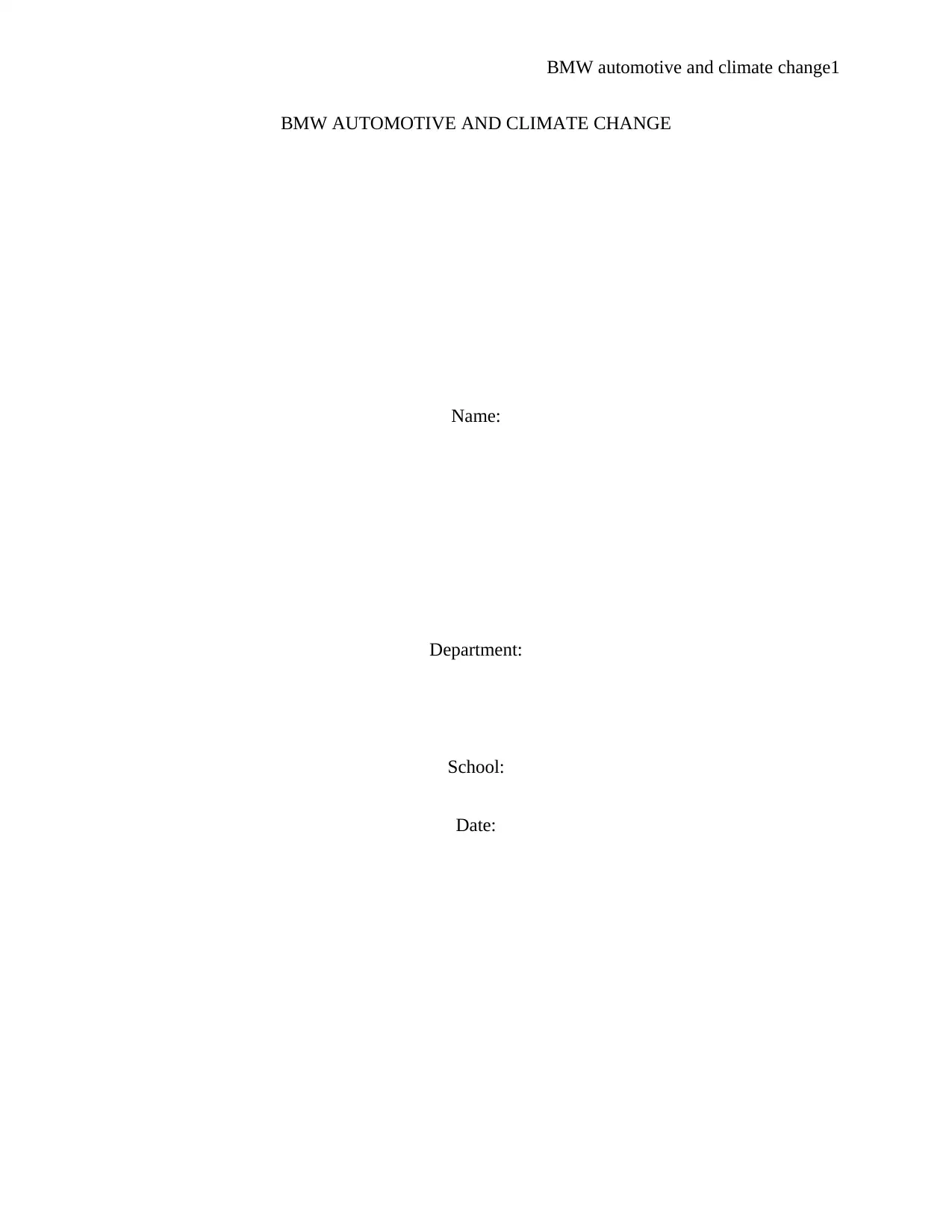
BMW automotive and climate change1
BMW AUTOMOTIVE AND CLIMATE CHANGE
Name:
Department:
School:
Date:
BMW AUTOMOTIVE AND CLIMATE CHANGE
Name:
Department:
School:
Date:
Paraphrase This Document
Need a fresh take? Get an instant paraphrase of this document with our AI Paraphraser
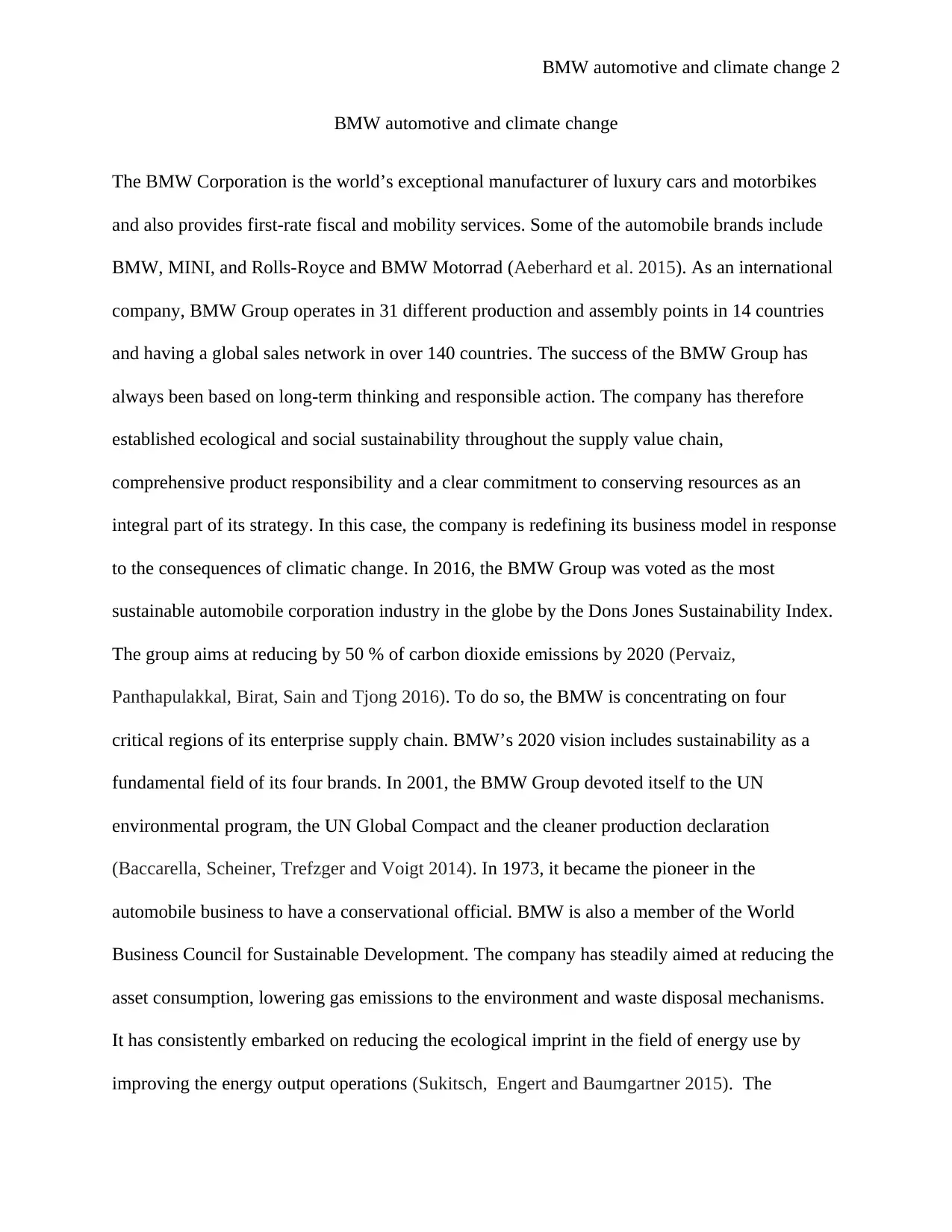
BMW automotive and climate change 2
BMW automotive and climate change
The BMW Corporation is the world’s exceptional manufacturer of luxury cars and motorbikes
and also provides first-rate fiscal and mobility services. Some of the automobile brands include
BMW, MINI, and Rolls-Royce and BMW Motorrad (Aeberhard et al. 2015). As an international
company, BMW Group operates in 31 different production and assembly points in 14 countries
and having a global sales network in over 140 countries. The success of the BMW Group has
always been based on long-term thinking and responsible action. The company has therefore
established ecological and social sustainability throughout the supply value chain,
comprehensive product responsibility and a clear commitment to conserving resources as an
integral part of its strategy. In this case, the company is redefining its business model in response
to the consequences of climatic change. In 2016, the BMW Group was voted as the most
sustainable automobile corporation industry in the globe by the Dons Jones Sustainability Index.
The group aims at reducing by 50 % of carbon dioxide emissions by 2020 (Pervaiz,
Panthapulakkal, Birat, Sain and Tjong 2016). To do so, the BMW is concentrating on four
critical regions of its enterprise supply chain. BMW’s 2020 vision includes sustainability as a
fundamental field of its four brands. In 2001, the BMW Group devoted itself to the UN
environmental program, the UN Global Compact and the cleaner production declaration
(Baccarella, Scheiner, Trefzger and Voigt 2014). In 1973, it became the pioneer in the
automobile business to have a conservational official. BMW is also a member of the World
Business Council for Sustainable Development. The company has steadily aimed at reducing the
asset consumption, lowering gas emissions to the environment and waste disposal mechanisms.
It has consistently embarked on reducing the ecological imprint in the field of energy use by
improving the energy output operations (Sukitsch, Engert and Baumgartner 2015). The
BMW automotive and climate change
The BMW Corporation is the world’s exceptional manufacturer of luxury cars and motorbikes
and also provides first-rate fiscal and mobility services. Some of the automobile brands include
BMW, MINI, and Rolls-Royce and BMW Motorrad (Aeberhard et al. 2015). As an international
company, BMW Group operates in 31 different production and assembly points in 14 countries
and having a global sales network in over 140 countries. The success of the BMW Group has
always been based on long-term thinking and responsible action. The company has therefore
established ecological and social sustainability throughout the supply value chain,
comprehensive product responsibility and a clear commitment to conserving resources as an
integral part of its strategy. In this case, the company is redefining its business model in response
to the consequences of climatic change. In 2016, the BMW Group was voted as the most
sustainable automobile corporation industry in the globe by the Dons Jones Sustainability Index.
The group aims at reducing by 50 % of carbon dioxide emissions by 2020 (Pervaiz,
Panthapulakkal, Birat, Sain and Tjong 2016). To do so, the BMW is concentrating on four
critical regions of its enterprise supply chain. BMW’s 2020 vision includes sustainability as a
fundamental field of its four brands. In 2001, the BMW Group devoted itself to the UN
environmental program, the UN Global Compact and the cleaner production declaration
(Baccarella, Scheiner, Trefzger and Voigt 2014). In 1973, it became the pioneer in the
automobile business to have a conservational official. BMW is also a member of the World
Business Council for Sustainable Development. The company has steadily aimed at reducing the
asset consumption, lowering gas emissions to the environment and waste disposal mechanisms.
It has consistently embarked on reducing the ecological imprint in the field of energy use by
improving the energy output operations (Sukitsch, Engert and Baumgartner 2015). The
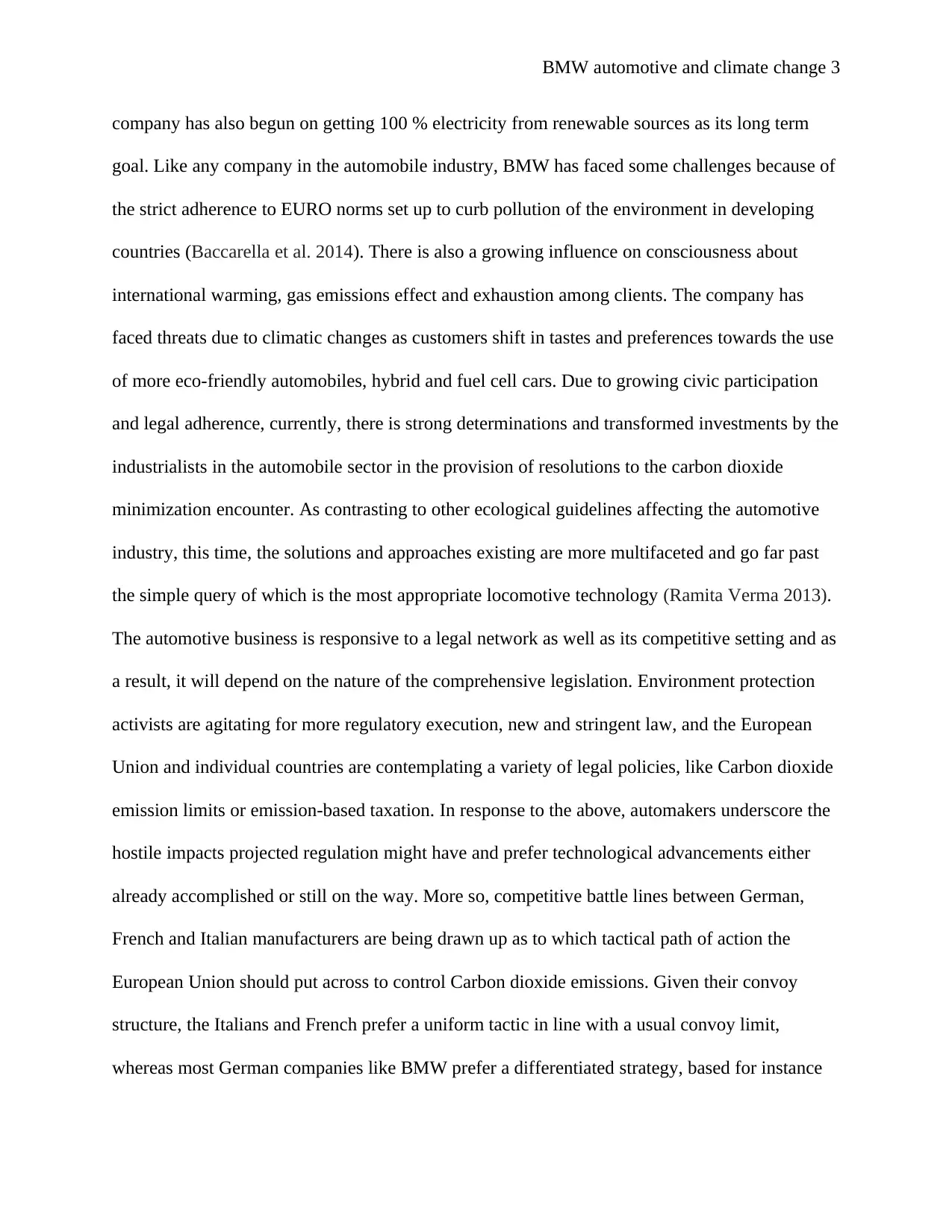
BMW automotive and climate change 3
company has also begun on getting 100 % electricity from renewable sources as its long term
goal. Like any company in the automobile industry, BMW has faced some challenges because of
the strict adherence to EURO norms set up to curb pollution of the environment in developing
countries (Baccarella et al. 2014). There is also a growing influence on consciousness about
international warming, gas emissions effect and exhaustion among clients. The company has
faced threats due to climatic changes as customers shift in tastes and preferences towards the use
of more eco-friendly automobiles, hybrid and fuel cell cars. Due to growing civic participation
and legal adherence, currently, there is strong determinations and transformed investments by the
industrialists in the automobile sector in the provision of resolutions to the carbon dioxide
minimization encounter. As contrasting to other ecological guidelines affecting the automotive
industry, this time, the solutions and approaches existing are more multifaceted and go far past
the simple query of which is the most appropriate locomotive technology (Ramita Verma 2013).
The automotive business is responsive to a legal network as well as its competitive setting and as
a result, it will depend on the nature of the comprehensive legislation. Environment protection
activists are agitating for more regulatory execution, new and stringent law, and the European
Union and individual countries are contemplating a variety of legal policies, like Carbon dioxide
emission limits or emission-based taxation. In response to the above, automakers underscore the
hostile impacts projected regulation might have and prefer technological advancements either
already accomplished or still on the way. More so, competitive battle lines between German,
French and Italian manufacturers are being drawn up as to which tactical path of action the
European Union should put across to control Carbon dioxide emissions. Given their convoy
structure, the Italians and French prefer a uniform tactic in line with a usual convoy limit,
whereas most German companies like BMW prefer a differentiated strategy, based for instance
company has also begun on getting 100 % electricity from renewable sources as its long term
goal. Like any company in the automobile industry, BMW has faced some challenges because of
the strict adherence to EURO norms set up to curb pollution of the environment in developing
countries (Baccarella et al. 2014). There is also a growing influence on consciousness about
international warming, gas emissions effect and exhaustion among clients. The company has
faced threats due to climatic changes as customers shift in tastes and preferences towards the use
of more eco-friendly automobiles, hybrid and fuel cell cars. Due to growing civic participation
and legal adherence, currently, there is strong determinations and transformed investments by the
industrialists in the automobile sector in the provision of resolutions to the carbon dioxide
minimization encounter. As contrasting to other ecological guidelines affecting the automotive
industry, this time, the solutions and approaches existing are more multifaceted and go far past
the simple query of which is the most appropriate locomotive technology (Ramita Verma 2013).
The automotive business is responsive to a legal network as well as its competitive setting and as
a result, it will depend on the nature of the comprehensive legislation. Environment protection
activists are agitating for more regulatory execution, new and stringent law, and the European
Union and individual countries are contemplating a variety of legal policies, like Carbon dioxide
emission limits or emission-based taxation. In response to the above, automakers underscore the
hostile impacts projected regulation might have and prefer technological advancements either
already accomplished or still on the way. More so, competitive battle lines between German,
French and Italian manufacturers are being drawn up as to which tactical path of action the
European Union should put across to control Carbon dioxide emissions. Given their convoy
structure, the Italians and French prefer a uniform tactic in line with a usual convoy limit,
whereas most German companies like BMW prefer a differentiated strategy, based for instance
⊘ This is a preview!⊘
Do you want full access?
Subscribe today to unlock all pages.

Trusted by 1+ million students worldwide
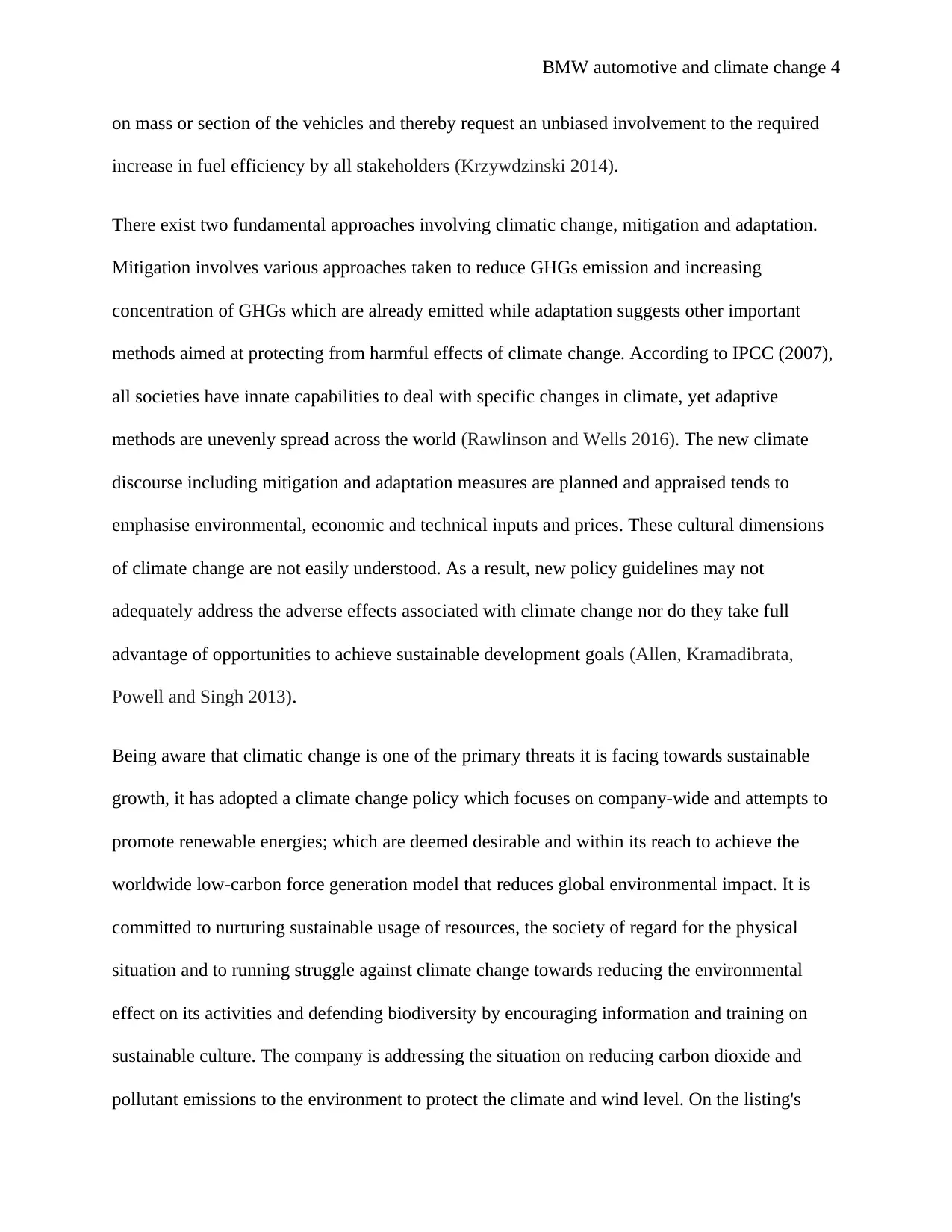
BMW automotive and climate change 4
on mass or section of the vehicles and thereby request an unbiased involvement to the required
increase in fuel efficiency by all stakeholders (Krzywdzinski 2014).
There exist two fundamental approaches involving climatic change, mitigation and adaptation.
Mitigation involves various approaches taken to reduce GHGs emission and increasing
concentration of GHGs which are already emitted while adaptation suggests other important
methods aimed at protecting from harmful effects of climate change. According to IPCC (2007),
all societies have innate capabilities to deal with specific changes in climate, yet adaptive
methods are unevenly spread across the world (Rawlinson and Wells 2016). The new climate
discourse including mitigation and adaptation measures are planned and appraised tends to
emphasise environmental, economic and technical inputs and prices. These cultural dimensions
of climate change are not easily understood. As a result, new policy guidelines may not
adequately address the adverse effects associated with climate change nor do they take full
advantage of opportunities to achieve sustainable development goals (Allen, Kramadibrata,
Powell and Singh 2013).
Being aware that climatic change is one of the primary threats it is facing towards sustainable
growth, it has adopted a climate change policy which focuses on company-wide and attempts to
promote renewable energies; which are deemed desirable and within its reach to achieve the
worldwide low-carbon force generation model that reduces global environmental impact. It is
committed to nurturing sustainable usage of resources, the society of regard for the physical
situation and to running struggle against climate change towards reducing the environmental
effect on its activities and defending biodiversity by encouraging information and training on
sustainable culture. The company is addressing the situation on reducing carbon dioxide and
pollutant emissions to the environment to protect the climate and wind level. On the listing's
on mass or section of the vehicles and thereby request an unbiased involvement to the required
increase in fuel efficiency by all stakeholders (Krzywdzinski 2014).
There exist two fundamental approaches involving climatic change, mitigation and adaptation.
Mitigation involves various approaches taken to reduce GHGs emission and increasing
concentration of GHGs which are already emitted while adaptation suggests other important
methods aimed at protecting from harmful effects of climate change. According to IPCC (2007),
all societies have innate capabilities to deal with specific changes in climate, yet adaptive
methods are unevenly spread across the world (Rawlinson and Wells 2016). The new climate
discourse including mitigation and adaptation measures are planned and appraised tends to
emphasise environmental, economic and technical inputs and prices. These cultural dimensions
of climate change are not easily understood. As a result, new policy guidelines may not
adequately address the adverse effects associated with climate change nor do they take full
advantage of opportunities to achieve sustainable development goals (Allen, Kramadibrata,
Powell and Singh 2013).
Being aware that climatic change is one of the primary threats it is facing towards sustainable
growth, it has adopted a climate change policy which focuses on company-wide and attempts to
promote renewable energies; which are deemed desirable and within its reach to achieve the
worldwide low-carbon force generation model that reduces global environmental impact. It is
committed to nurturing sustainable usage of resources, the society of regard for the physical
situation and to running struggle against climate change towards reducing the environmental
effect on its activities and defending biodiversity by encouraging information and training on
sustainable culture. The company is addressing the situation on reducing carbon dioxide and
pollutant emissions to the environment to protect the climate and wind level. On the listing's
Paraphrase This Document
Need a fresh take? Get an instant paraphrase of this document with our AI Paraphraser
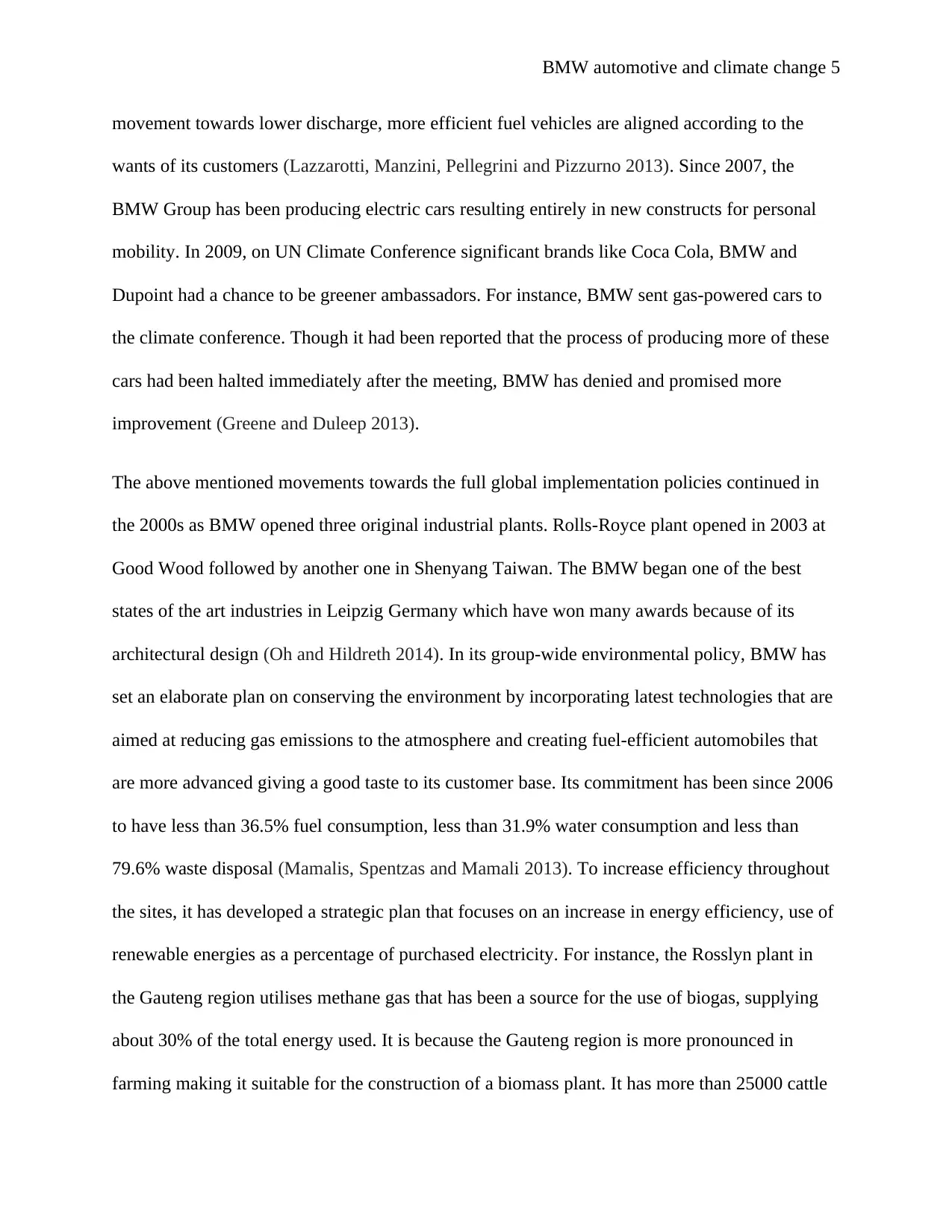
BMW automotive and climate change 5
movement towards lower discharge, more efficient fuel vehicles are aligned according to the
wants of its customers (Lazzarotti, Manzini, Pellegrini and Pizzurno 2013). Since 2007, the
BMW Group has been producing electric cars resulting entirely in new constructs for personal
mobility. In 2009, on UN Climate Conference significant brands like Coca Cola, BMW and
Dupoint had a chance to be greener ambassadors. For instance, BMW sent gas-powered cars to
the climate conference. Though it had been reported that the process of producing more of these
cars had been halted immediately after the meeting, BMW has denied and promised more
improvement (Greene and Duleep 2013).
The above mentioned movements towards the full global implementation policies continued in
the 2000s as BMW opened three original industrial plants. Rolls-Royce plant opened in 2003 at
Good Wood followed by another one in Shenyang Taiwan. The BMW began one of the best
states of the art industries in Leipzig Germany which have won many awards because of its
architectural design (Oh and Hildreth 2014). In its group-wide environmental policy, BMW has
set an elaborate plan on conserving the environment by incorporating latest technologies that are
aimed at reducing gas emissions to the atmosphere and creating fuel-efficient automobiles that
are more advanced giving a good taste to its customer base. Its commitment has been since 2006
to have less than 36.5% fuel consumption, less than 31.9% water consumption and less than
79.6% waste disposal (Mamalis, Spentzas and Mamali 2013). To increase efficiency throughout
the sites, it has developed a strategic plan that focuses on an increase in energy efficiency, use of
renewable energies as a percentage of purchased electricity. For instance, the Rosslyn plant in
the Gauteng region utilises methane gas that has been a source for the use of biogas, supplying
about 30% of the total energy used. It is because the Gauteng region is more pronounced in
farming making it suitable for the construction of a biomass plant. It has more than 25000 cattle
movement towards lower discharge, more efficient fuel vehicles are aligned according to the
wants of its customers (Lazzarotti, Manzini, Pellegrini and Pizzurno 2013). Since 2007, the
BMW Group has been producing electric cars resulting entirely in new constructs for personal
mobility. In 2009, on UN Climate Conference significant brands like Coca Cola, BMW and
Dupoint had a chance to be greener ambassadors. For instance, BMW sent gas-powered cars to
the climate conference. Though it had been reported that the process of producing more of these
cars had been halted immediately after the meeting, BMW has denied and promised more
improvement (Greene and Duleep 2013).
The above mentioned movements towards the full global implementation policies continued in
the 2000s as BMW opened three original industrial plants. Rolls-Royce plant opened in 2003 at
Good Wood followed by another one in Shenyang Taiwan. The BMW began one of the best
states of the art industries in Leipzig Germany which have won many awards because of its
architectural design (Oh and Hildreth 2014). In its group-wide environmental policy, BMW has
set an elaborate plan on conserving the environment by incorporating latest technologies that are
aimed at reducing gas emissions to the atmosphere and creating fuel-efficient automobiles that
are more advanced giving a good taste to its customer base. Its commitment has been since 2006
to have less than 36.5% fuel consumption, less than 31.9% water consumption and less than
79.6% waste disposal (Mamalis, Spentzas and Mamali 2013). To increase efficiency throughout
the sites, it has developed a strategic plan that focuses on an increase in energy efficiency, use of
renewable energies as a percentage of purchased electricity. For instance, the Rosslyn plant in
the Gauteng region utilises methane gas that has been a source for the use of biogas, supplying
about 30% of the total energy used. It is because the Gauteng region is more pronounced in
farming making it suitable for the construction of a biomass plant. It has more than 25000 cattle
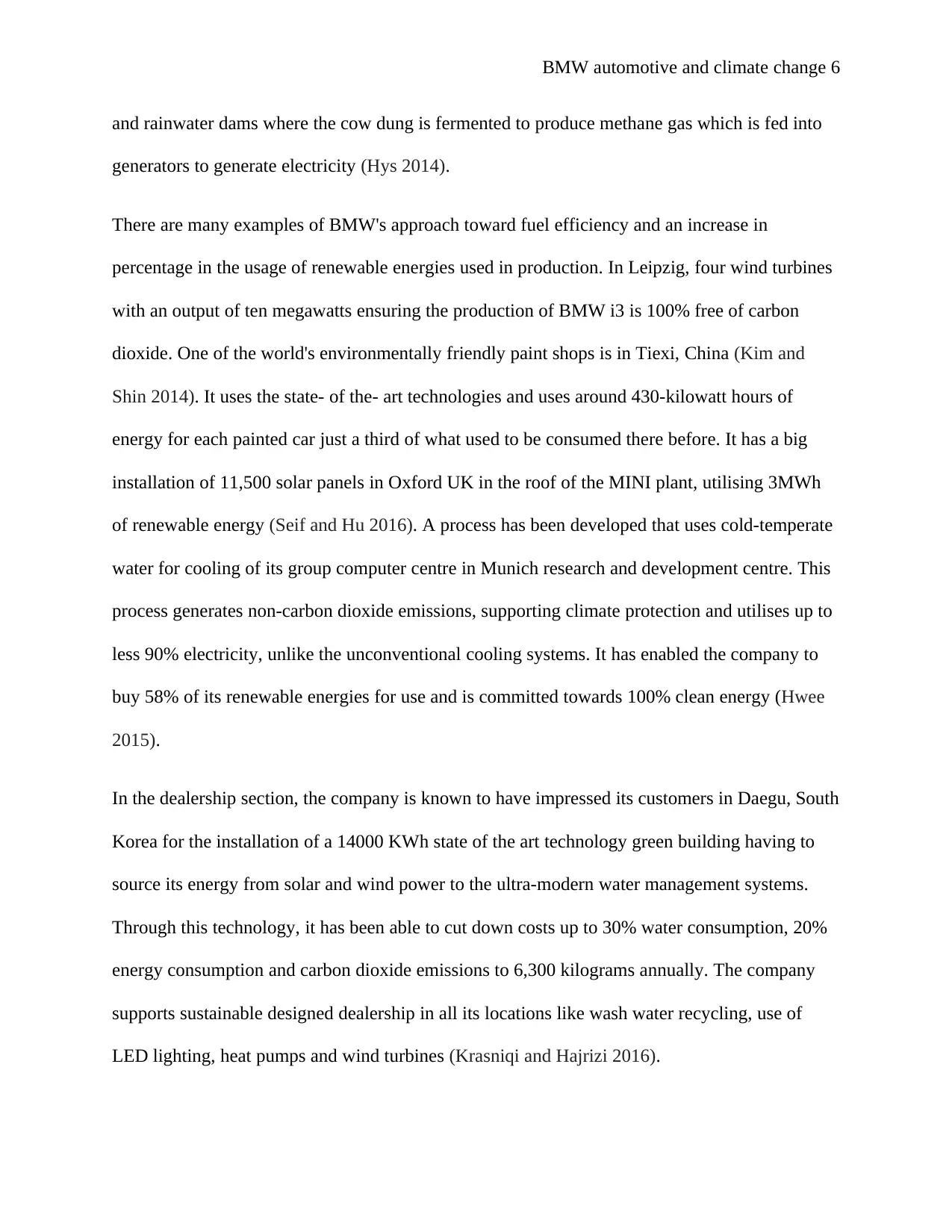
BMW automotive and climate change 6
and rainwater dams where the cow dung is fermented to produce methane gas which is fed into
generators to generate electricity (Hys 2014).
There are many examples of BMW's approach toward fuel efficiency and an increase in
percentage in the usage of renewable energies used in production. In Leipzig, four wind turbines
with an output of ten megawatts ensuring the production of BMW i3 is 100% free of carbon
dioxide. One of the world's environmentally friendly paint shops is in Tiexi, China (Kim and
Shin 2014). It uses the state- of the- art technologies and uses around 430-kilowatt hours of
energy for each painted car just a third of what used to be consumed there before. It has a big
installation of 11,500 solar panels in Oxford UK in the roof of the MINI plant, utilising 3MWh
of renewable energy (Seif and Hu 2016). A process has been developed that uses cold-temperate
water for cooling of its group computer centre in Munich research and development centre. This
process generates non-carbon dioxide emissions, supporting climate protection and utilises up to
less 90% electricity, unlike the unconventional cooling systems. It has enabled the company to
buy 58% of its renewable energies for use and is committed towards 100% clean energy (Hwee
2015).
In the dealership section, the company is known to have impressed its customers in Daegu, South
Korea for the installation of a 14000 KWh state of the art technology green building having to
source its energy from solar and wind power to the ultra-modern water management systems.
Through this technology, it has been able to cut down costs up to 30% water consumption, 20%
energy consumption and carbon dioxide emissions to 6,300 kilograms annually. The company
supports sustainable designed dealership in all its locations like wash water recycling, use of
LED lighting, heat pumps and wind turbines (Krasniqi and Hajrizi 2016).
and rainwater dams where the cow dung is fermented to produce methane gas which is fed into
generators to generate electricity (Hys 2014).
There are many examples of BMW's approach toward fuel efficiency and an increase in
percentage in the usage of renewable energies used in production. In Leipzig, four wind turbines
with an output of ten megawatts ensuring the production of BMW i3 is 100% free of carbon
dioxide. One of the world's environmentally friendly paint shops is in Tiexi, China (Kim and
Shin 2014). It uses the state- of the- art technologies and uses around 430-kilowatt hours of
energy for each painted car just a third of what used to be consumed there before. It has a big
installation of 11,500 solar panels in Oxford UK in the roof of the MINI plant, utilising 3MWh
of renewable energy (Seif and Hu 2016). A process has been developed that uses cold-temperate
water for cooling of its group computer centre in Munich research and development centre. This
process generates non-carbon dioxide emissions, supporting climate protection and utilises up to
less 90% electricity, unlike the unconventional cooling systems. It has enabled the company to
buy 58% of its renewable energies for use and is committed towards 100% clean energy (Hwee
2015).
In the dealership section, the company is known to have impressed its customers in Daegu, South
Korea for the installation of a 14000 KWh state of the art technology green building having to
source its energy from solar and wind power to the ultra-modern water management systems.
Through this technology, it has been able to cut down costs up to 30% water consumption, 20%
energy consumption and carbon dioxide emissions to 6,300 kilograms annually. The company
supports sustainable designed dealership in all its locations like wash water recycling, use of
LED lighting, heat pumps and wind turbines (Krasniqi and Hajrizi 2016).
⊘ This is a preview!⊘
Do you want full access?
Subscribe today to unlock all pages.

Trusted by 1+ million students worldwide
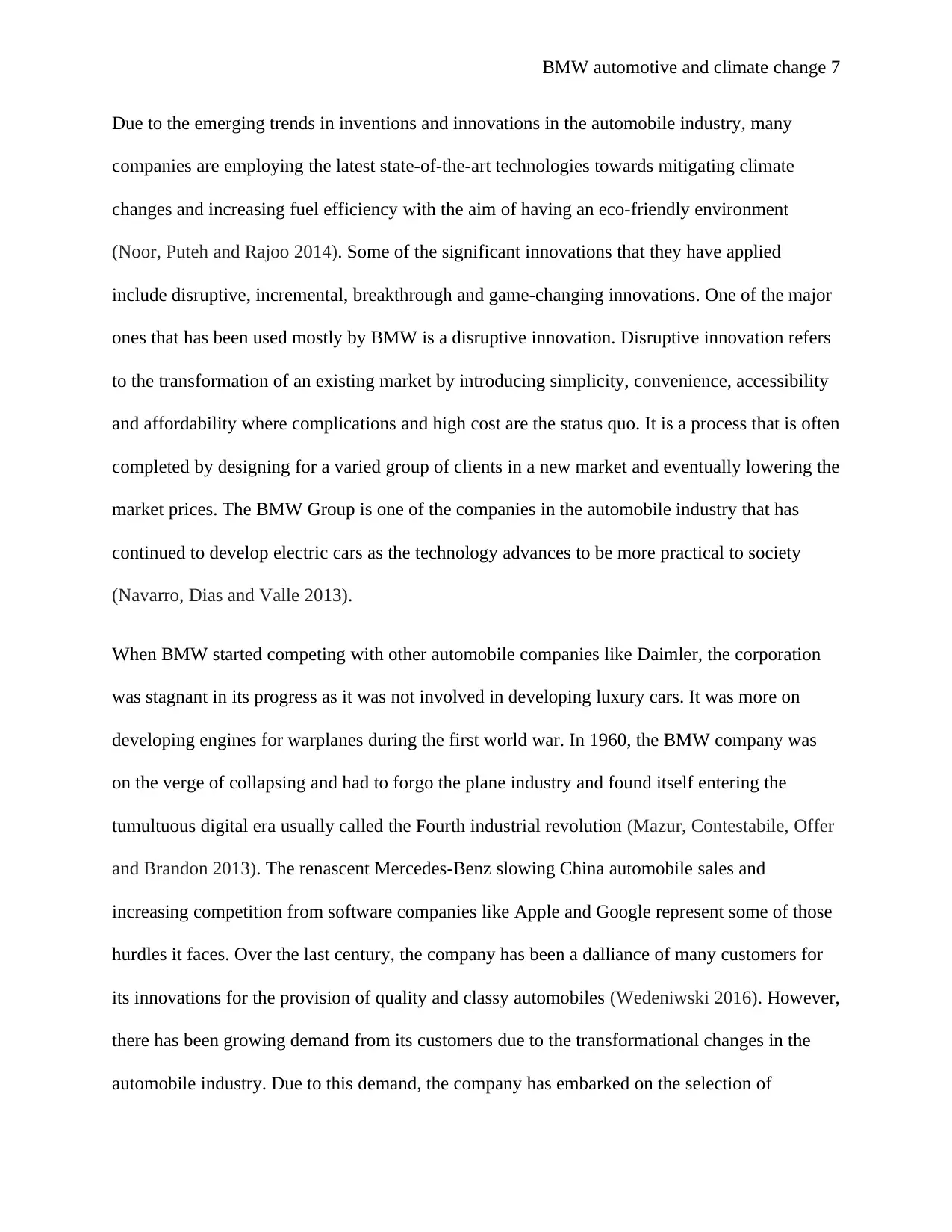
BMW automotive and climate change 7
Due to the emerging trends in inventions and innovations in the automobile industry, many
companies are employing the latest state-of-the-art technologies towards mitigating climate
changes and increasing fuel efficiency with the aim of having an eco-friendly environment
(Noor, Puteh and Rajoo 2014). Some of the significant innovations that they have applied
include disruptive, incremental, breakthrough and game-changing innovations. One of the major
ones that has been used mostly by BMW is a disruptive innovation. Disruptive innovation refers
to the transformation of an existing market by introducing simplicity, convenience, accessibility
and affordability where complications and high cost are the status quo. It is a process that is often
completed by designing for a varied group of clients in a new market and eventually lowering the
market prices. The BMW Group is one of the companies in the automobile industry that has
continued to develop electric cars as the technology advances to be more practical to society
(Navarro, Dias and Valle 2013).
When BMW started competing with other automobile companies like Daimler, the corporation
was stagnant in its progress as it was not involved in developing luxury cars. It was more on
developing engines for warplanes during the first world war. In 1960, the BMW company was
on the verge of collapsing and had to forgo the plane industry and found itself entering the
tumultuous digital era usually called the Fourth industrial revolution (Mazur, Contestabile, Offer
and Brandon 2013). The renascent Mercedes-Benz slowing China automobile sales and
increasing competition from software companies like Apple and Google represent some of those
hurdles it faces. Over the last century, the company has been a dalliance of many customers for
its innovations for the provision of quality and classy automobiles (Wedeniwski 2016). However,
there has been growing demand from its customers due to the transformational changes in the
automobile industry. Due to this demand, the company has embarked on the selection of
Due to the emerging trends in inventions and innovations in the automobile industry, many
companies are employing the latest state-of-the-art technologies towards mitigating climate
changes and increasing fuel efficiency with the aim of having an eco-friendly environment
(Noor, Puteh and Rajoo 2014). Some of the significant innovations that they have applied
include disruptive, incremental, breakthrough and game-changing innovations. One of the major
ones that has been used mostly by BMW is a disruptive innovation. Disruptive innovation refers
to the transformation of an existing market by introducing simplicity, convenience, accessibility
and affordability where complications and high cost are the status quo. It is a process that is often
completed by designing for a varied group of clients in a new market and eventually lowering the
market prices. The BMW Group is one of the companies in the automobile industry that has
continued to develop electric cars as the technology advances to be more practical to society
(Navarro, Dias and Valle 2013).
When BMW started competing with other automobile companies like Daimler, the corporation
was stagnant in its progress as it was not involved in developing luxury cars. It was more on
developing engines for warplanes during the first world war. In 1960, the BMW company was
on the verge of collapsing and had to forgo the plane industry and found itself entering the
tumultuous digital era usually called the Fourth industrial revolution (Mazur, Contestabile, Offer
and Brandon 2013). The renascent Mercedes-Benz slowing China automobile sales and
increasing competition from software companies like Apple and Google represent some of those
hurdles it faces. Over the last century, the company has been a dalliance of many customers for
its innovations for the provision of quality and classy automobiles (Wedeniwski 2016). However,
there has been growing demand from its customers due to the transformational changes in the
automobile industry. Due to this demand, the company has embarked on the selection of
Paraphrase This Document
Need a fresh take? Get an instant paraphrase of this document with our AI Paraphraser
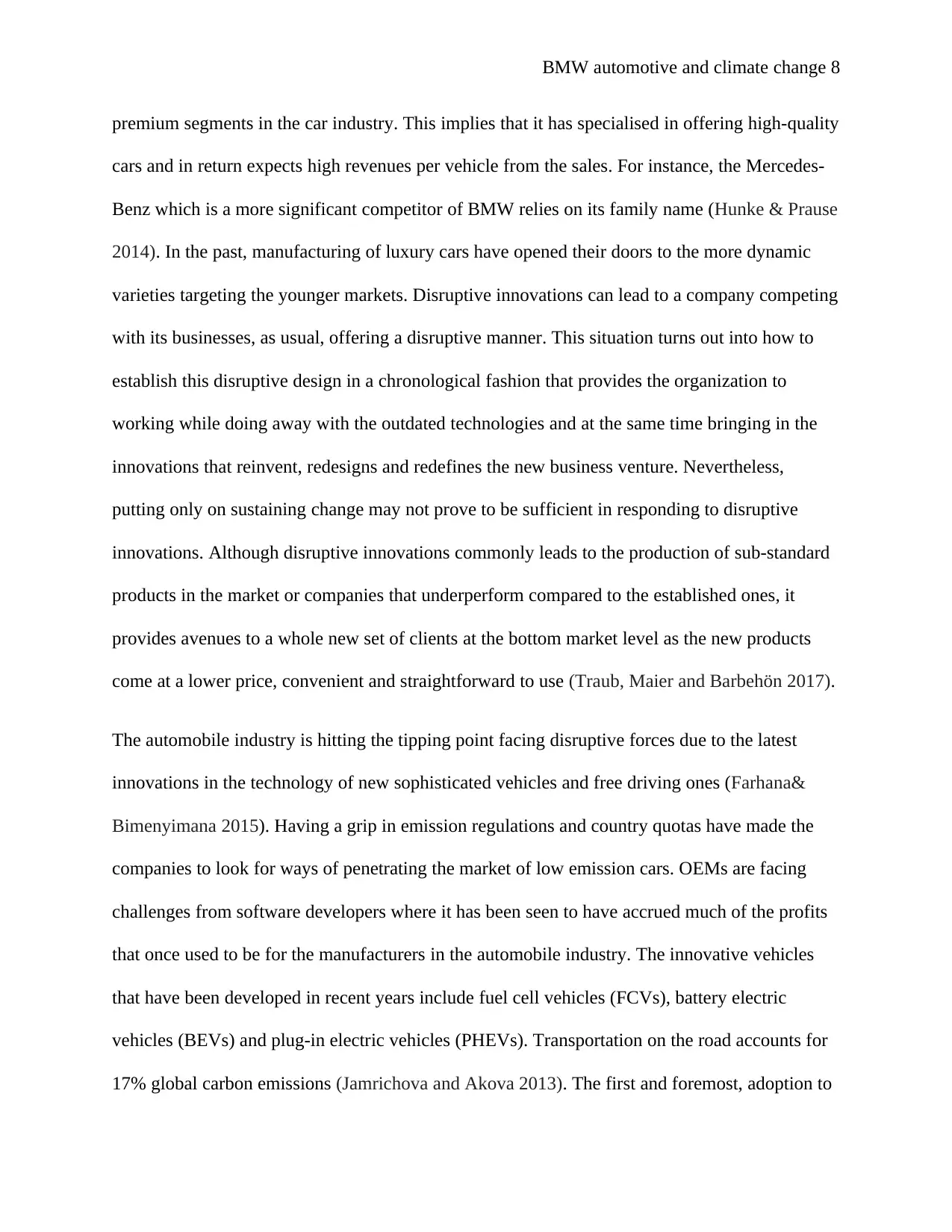
BMW automotive and climate change 8
premium segments in the car industry. This implies that it has specialised in offering high-quality
cars and in return expects high revenues per vehicle from the sales. For instance, the Mercedes-
Benz which is a more significant competitor of BMW relies on its family name (Hunke & Prause
2014). In the past, manufacturing of luxury cars have opened their doors to the more dynamic
varieties targeting the younger markets. Disruptive innovations can lead to a company competing
with its businesses, as usual, offering a disruptive manner. This situation turns out into how to
establish this disruptive design in a chronological fashion that provides the organization to
working while doing away with the outdated technologies and at the same time bringing in the
innovations that reinvent, redesigns and redefines the new business venture. Nevertheless,
putting only on sustaining change may not prove to be sufficient in responding to disruptive
innovations. Although disruptive innovations commonly leads to the production of sub-standard
products in the market or companies that underperform compared to the established ones, it
provides avenues to a whole new set of clients at the bottom market level as the new products
come at a lower price, convenient and straightforward to use (Traub, Maier and Barbehön 2017).
The automobile industry is hitting the tipping point facing disruptive forces due to the latest
innovations in the technology of new sophisticated vehicles and free driving ones (Farhana&
Bimenyimana 2015). Having a grip in emission regulations and country quotas have made the
companies to look for ways of penetrating the market of low emission cars. OEMs are facing
challenges from software developers where it has been seen to have accrued much of the profits
that once used to be for the manufacturers in the automobile industry. The innovative vehicles
that have been developed in recent years include fuel cell vehicles (FCVs), battery electric
vehicles (BEVs) and plug-in electric vehicles (PHEVs). Transportation on the road accounts for
17% global carbon emissions (Jamrichova and Akova 2013). The first and foremost, adoption to
premium segments in the car industry. This implies that it has specialised in offering high-quality
cars and in return expects high revenues per vehicle from the sales. For instance, the Mercedes-
Benz which is a more significant competitor of BMW relies on its family name (Hunke & Prause
2014). In the past, manufacturing of luxury cars have opened their doors to the more dynamic
varieties targeting the younger markets. Disruptive innovations can lead to a company competing
with its businesses, as usual, offering a disruptive manner. This situation turns out into how to
establish this disruptive design in a chronological fashion that provides the organization to
working while doing away with the outdated technologies and at the same time bringing in the
innovations that reinvent, redesigns and redefines the new business venture. Nevertheless,
putting only on sustaining change may not prove to be sufficient in responding to disruptive
innovations. Although disruptive innovations commonly leads to the production of sub-standard
products in the market or companies that underperform compared to the established ones, it
provides avenues to a whole new set of clients at the bottom market level as the new products
come at a lower price, convenient and straightforward to use (Traub, Maier and Barbehön 2017).
The automobile industry is hitting the tipping point facing disruptive forces due to the latest
innovations in the technology of new sophisticated vehicles and free driving ones (Farhana&
Bimenyimana 2015). Having a grip in emission regulations and country quotas have made the
companies to look for ways of penetrating the market of low emission cars. OEMs are facing
challenges from software developers where it has been seen to have accrued much of the profits
that once used to be for the manufacturers in the automobile industry. The innovative vehicles
that have been developed in recent years include fuel cell vehicles (FCVs), battery electric
vehicles (BEVs) and plug-in electric vehicles (PHEVs). Transportation on the road accounts for
17% global carbon emissions (Jamrichova and Akova 2013). The first and foremost, adoption to
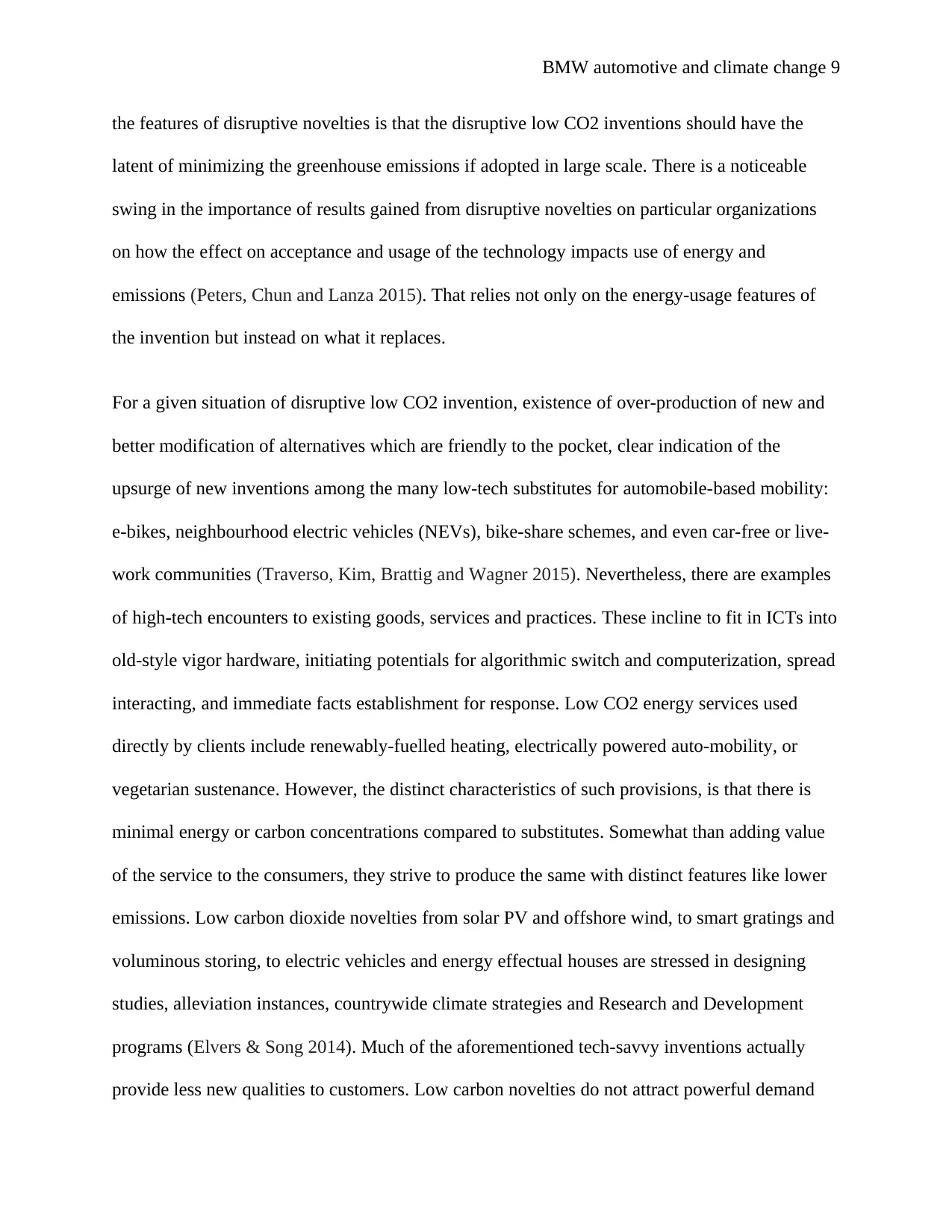
BMW automotive and climate change 9
the features of disruptive novelties is that the disruptive low CO2 inventions should have the
latent of minimizing the greenhouse emissions if adopted in large scale. There is a noticeable
swing in the importance of results gained from disruptive novelties on particular organizations
on how the effect on acceptance and usage of the technology impacts use of energy and
emissions (Peters, Chun and Lanza 2015). That relies not only on the energy-usage features of
the invention but instead on what it replaces.
For a given situation of disruptive low CO2 invention, existence of over-production of new and
better modification of alternatives which are friendly to the pocket, clear indication of the
upsurge of new inventions among the many low-tech substitutes for automobile-based mobility:
e-bikes, neighbourhood electric vehicles (NEVs), bike-share schemes, and even car-free or live-
work communities (Traverso, Kim, Brattig and Wagner 2015). Nevertheless, there are examples
of high-tech encounters to existing goods, services and practices. These incline to fit in ICTs into
old-style vigor hardware, initiating potentials for algorithmic switch and computerization, spread
interacting, and immediate facts establishment for response. Low CO2 energy services used
directly by clients include renewably-fuelled heating, electrically powered auto-mobility, or
vegetarian sustenance. However, the distinct characteristics of such provisions, is that there is
minimal energy or carbon concentrations compared to substitutes. Somewhat than adding value
of the service to the consumers, they strive to produce the same with distinct features like lower
emissions. Low carbon dioxide novelties from solar PV and offshore wind, to smart gratings and
voluminous storing, to electric vehicles and energy effectual houses are stressed in designing
studies, alleviation instances, countrywide climate strategies and Research and Development
programs (Elvers & Song 2014). Much of the aforementioned tech-savvy inventions actually
provide less new qualities to customers. Low carbon novelties do not attract powerful demand
the features of disruptive novelties is that the disruptive low CO2 inventions should have the
latent of minimizing the greenhouse emissions if adopted in large scale. There is a noticeable
swing in the importance of results gained from disruptive novelties on particular organizations
on how the effect on acceptance and usage of the technology impacts use of energy and
emissions (Peters, Chun and Lanza 2015). That relies not only on the energy-usage features of
the invention but instead on what it replaces.
For a given situation of disruptive low CO2 invention, existence of over-production of new and
better modification of alternatives which are friendly to the pocket, clear indication of the
upsurge of new inventions among the many low-tech substitutes for automobile-based mobility:
e-bikes, neighbourhood electric vehicles (NEVs), bike-share schemes, and even car-free or live-
work communities (Traverso, Kim, Brattig and Wagner 2015). Nevertheless, there are examples
of high-tech encounters to existing goods, services and practices. These incline to fit in ICTs into
old-style vigor hardware, initiating potentials for algorithmic switch and computerization, spread
interacting, and immediate facts establishment for response. Low CO2 energy services used
directly by clients include renewably-fuelled heating, electrically powered auto-mobility, or
vegetarian sustenance. However, the distinct characteristics of such provisions, is that there is
minimal energy or carbon concentrations compared to substitutes. Somewhat than adding value
of the service to the consumers, they strive to produce the same with distinct features like lower
emissions. Low carbon dioxide novelties from solar PV and offshore wind, to smart gratings and
voluminous storing, to electric vehicles and energy effectual houses are stressed in designing
studies, alleviation instances, countrywide climate strategies and Research and Development
programs (Elvers & Song 2014). Much of the aforementioned tech-savvy inventions actually
provide less new qualities to customers. Low carbon novelties do not attract powerful demand
⊘ This is a preview!⊘
Do you want full access?
Subscribe today to unlock all pages.

Trusted by 1+ million students worldwide
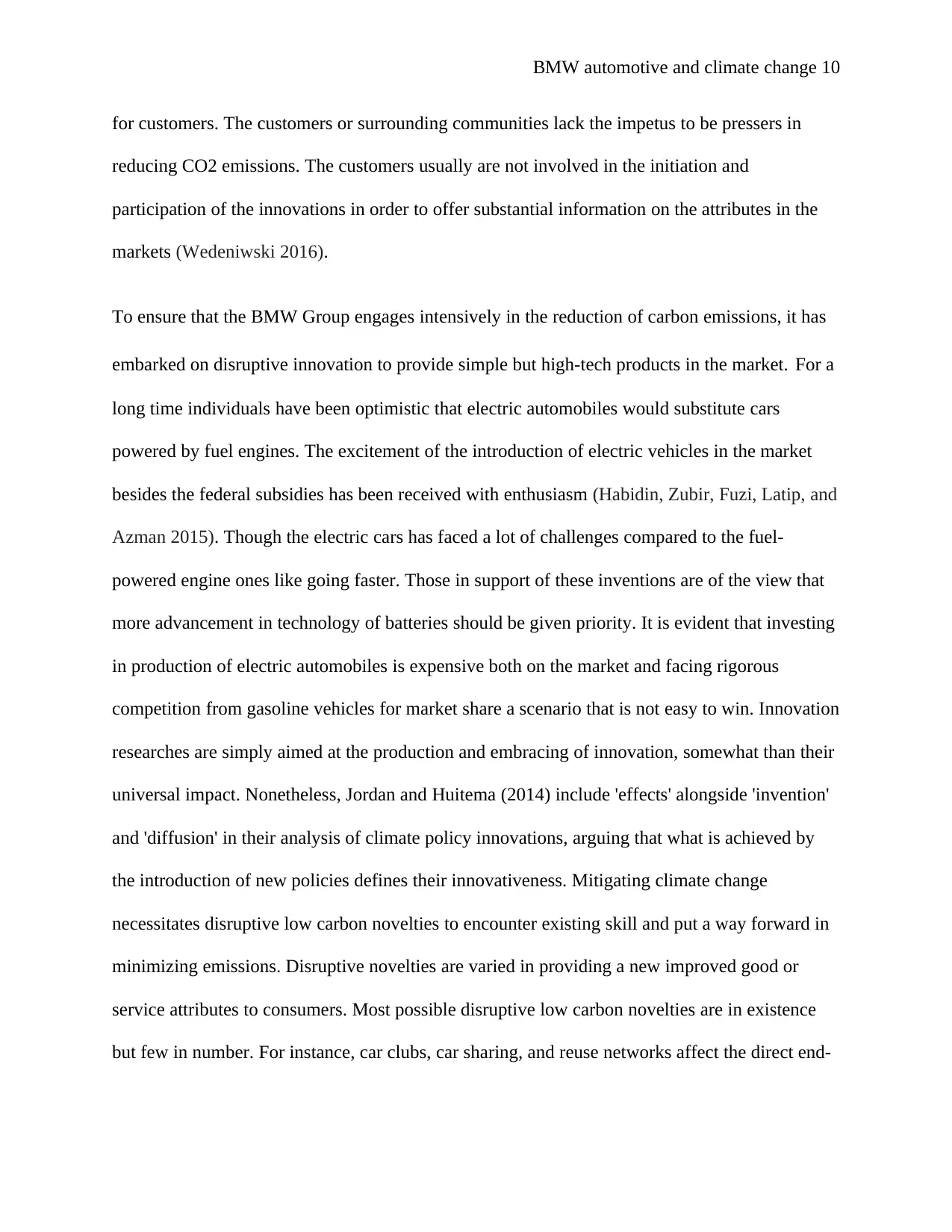
BMW automotive and climate change 10
for customers. The customers or surrounding communities lack the impetus to be pressers in
reducing CO2 emissions. The customers usually are not involved in the initiation and
participation of the innovations in order to offer substantial information on the attributes in the
markets (Wedeniwski 2016).
To ensure that the BMW Group engages intensively in the reduction of carbon emissions, it has
embarked on disruptive innovation to provide simple but high-tech products in the market. For a
long time individuals have been optimistic that electric automobiles would substitute cars
powered by fuel engines. The excitement of the introduction of electric vehicles in the market
besides the federal subsidies has been received with enthusiasm (Habidin, Zubir, Fuzi, Latip, and
Azman 2015). Though the electric cars has faced a lot of challenges compared to the fuel-
powered engine ones like going faster. Those in support of these inventions are of the view that
more advancement in technology of batteries should be given priority. It is evident that investing
in production of electric automobiles is expensive both on the market and facing rigorous
competition from gasoline vehicles for market share a scenario that is not easy to win. Innovation
researches are simply aimed at the production and embracing of innovation, somewhat than their
universal impact. Nonetheless, Jordan and Huitema (2014) include 'effects' alongside 'invention'
and 'diffusion' in their analysis of climate policy innovations, arguing that what is achieved by
the introduction of new policies defines their innovativeness. Mitigating climate change
necessitates disruptive low carbon novelties to encounter existing skill and put a way forward in
minimizing emissions. Disruptive novelties are varied in providing a new improved good or
service attributes to consumers. Most possible disruptive low carbon novelties are in existence
but few in number. For instance, car clubs, car sharing, and reuse networks affect the direct end-
for customers. The customers or surrounding communities lack the impetus to be pressers in
reducing CO2 emissions. The customers usually are not involved in the initiation and
participation of the innovations in order to offer substantial information on the attributes in the
markets (Wedeniwski 2016).
To ensure that the BMW Group engages intensively in the reduction of carbon emissions, it has
embarked on disruptive innovation to provide simple but high-tech products in the market. For a
long time individuals have been optimistic that electric automobiles would substitute cars
powered by fuel engines. The excitement of the introduction of electric vehicles in the market
besides the federal subsidies has been received with enthusiasm (Habidin, Zubir, Fuzi, Latip, and
Azman 2015). Though the electric cars has faced a lot of challenges compared to the fuel-
powered engine ones like going faster. Those in support of these inventions are of the view that
more advancement in technology of batteries should be given priority. It is evident that investing
in production of electric automobiles is expensive both on the market and facing rigorous
competition from gasoline vehicles for market share a scenario that is not easy to win. Innovation
researches are simply aimed at the production and embracing of innovation, somewhat than their
universal impact. Nonetheless, Jordan and Huitema (2014) include 'effects' alongside 'invention'
and 'diffusion' in their analysis of climate policy innovations, arguing that what is achieved by
the introduction of new policies defines their innovativeness. Mitigating climate change
necessitates disruptive low carbon novelties to encounter existing skill and put a way forward in
minimizing emissions. Disruptive novelties are varied in providing a new improved good or
service attributes to consumers. Most possible disruptive low carbon novelties are in existence
but few in number. For instance, car clubs, car sharing, and reuse networks affect the direct end-
Paraphrase This Document
Need a fresh take? Get an instant paraphrase of this document with our AI Paraphraser
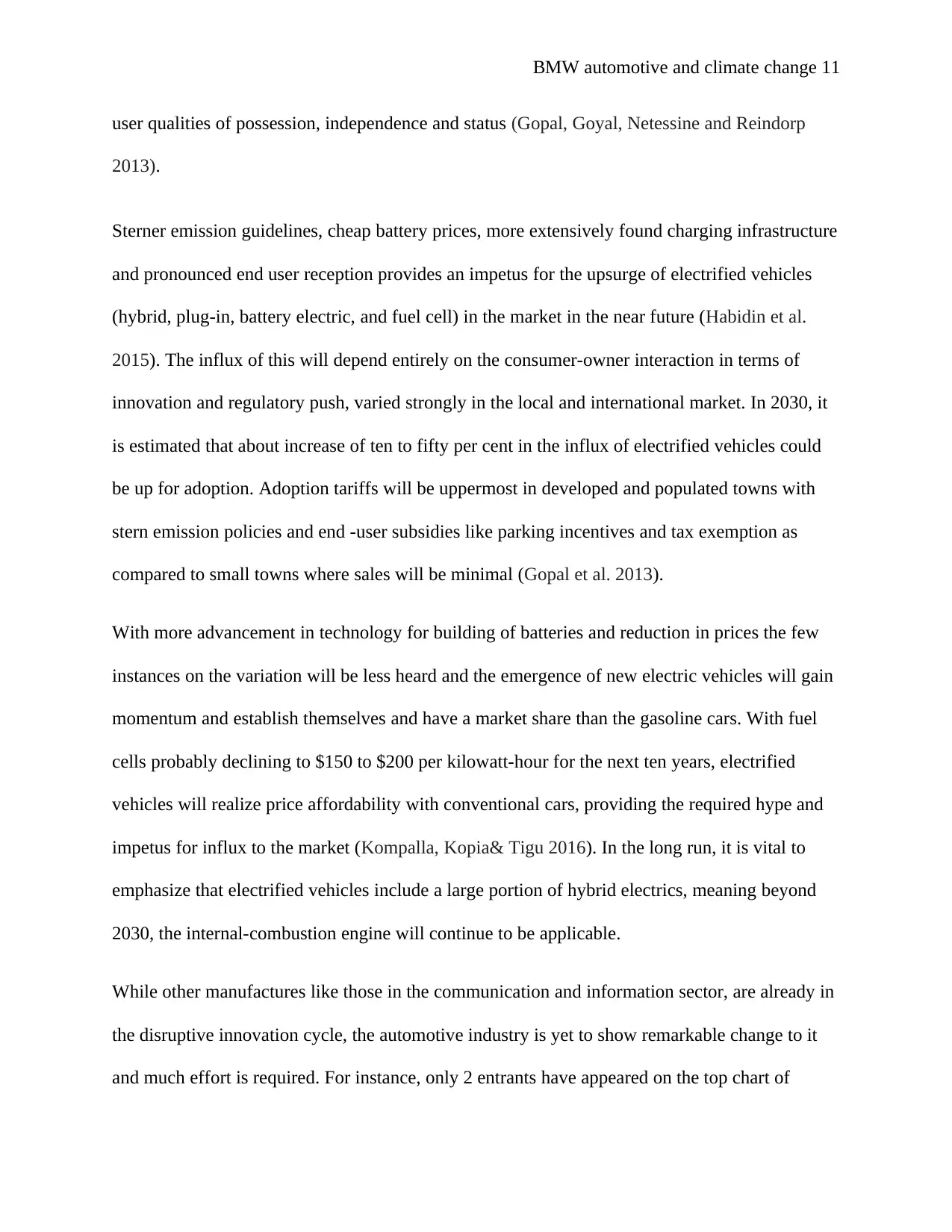
BMW automotive and climate change 11
user qualities of possession, independence and status (Gopal, Goyal, Netessine and Reindorp
2013).
Sterner emission guidelines, cheap battery prices, more extensively found charging infrastructure
and pronounced end user reception provides an impetus for the upsurge of electrified vehicles
(hybrid, plug-in, battery electric, and fuel cell) in the market in the near future (Habidin et al.
2015). The influx of this will depend entirely on the consumer-owner interaction in terms of
innovation and regulatory push, varied strongly in the local and international market. In 2030, it
is estimated that about increase of ten to fifty per cent in the influx of electrified vehicles could
be up for adoption. Adoption tariffs will be uppermost in developed and populated towns with
stern emission policies and end -user subsidies like parking incentives and tax exemption as
compared to small towns where sales will be minimal (Gopal et al. 2013).
With more advancement in technology for building of batteries and reduction in prices the few
instances on the variation will be less heard and the emergence of new electric vehicles will gain
momentum and establish themselves and have a market share than the gasoline cars. With fuel
cells probably declining to $150 to $200 per kilowatt-hour for the next ten years, electrified
vehicles will realize price affordability with conventional cars, providing the required hype and
impetus for influx to the market (Kompalla, Kopia& Tigu 2016). In the long run, it is vital to
emphasize that electrified vehicles include a large portion of hybrid electrics, meaning beyond
2030, the internal-combustion engine will continue to be applicable.
While other manufactures like those in the communication and information sector, are already in
the disruptive innovation cycle, the automotive industry is yet to show remarkable change to it
and much effort is required. For instance, only 2 entrants have appeared on the top chart of
user qualities of possession, independence and status (Gopal, Goyal, Netessine and Reindorp
2013).
Sterner emission guidelines, cheap battery prices, more extensively found charging infrastructure
and pronounced end user reception provides an impetus for the upsurge of electrified vehicles
(hybrid, plug-in, battery electric, and fuel cell) in the market in the near future (Habidin et al.
2015). The influx of this will depend entirely on the consumer-owner interaction in terms of
innovation and regulatory push, varied strongly in the local and international market. In 2030, it
is estimated that about increase of ten to fifty per cent in the influx of electrified vehicles could
be up for adoption. Adoption tariffs will be uppermost in developed and populated towns with
stern emission policies and end -user subsidies like parking incentives and tax exemption as
compared to small towns where sales will be minimal (Gopal et al. 2013).
With more advancement in technology for building of batteries and reduction in prices the few
instances on the variation will be less heard and the emergence of new electric vehicles will gain
momentum and establish themselves and have a market share than the gasoline cars. With fuel
cells probably declining to $150 to $200 per kilowatt-hour for the next ten years, electrified
vehicles will realize price affordability with conventional cars, providing the required hype and
impetus for influx to the market (Kompalla, Kopia& Tigu 2016). In the long run, it is vital to
emphasize that electrified vehicles include a large portion of hybrid electrics, meaning beyond
2030, the internal-combustion engine will continue to be applicable.
While other manufactures like those in the communication and information sector, are already in
the disruptive innovation cycle, the automotive industry is yet to show remarkable change to it
and much effort is required. For instance, only 2 entrants have appeared on the top chart of
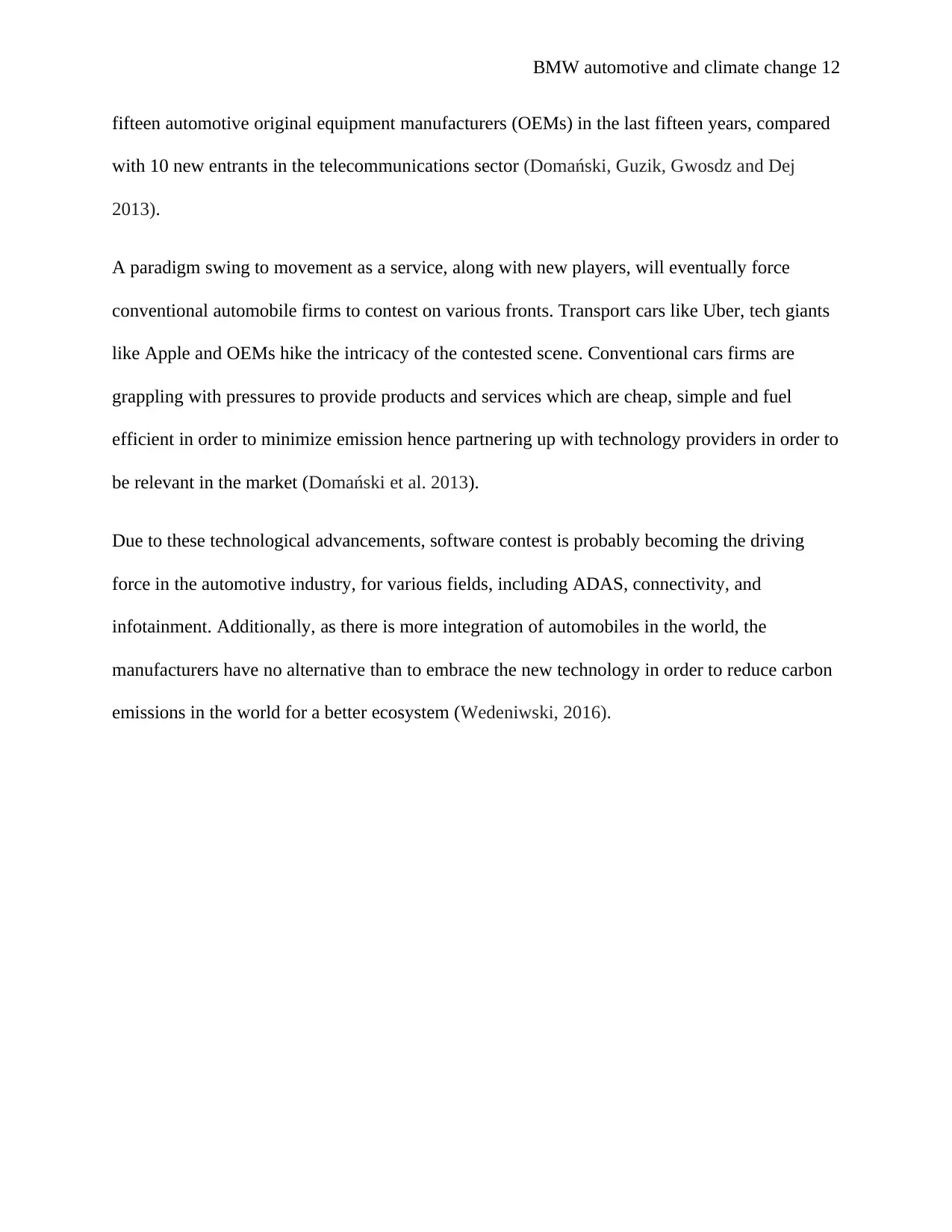
BMW automotive and climate change 12
fifteen automotive original equipment manufacturers (OEMs) in the last fifteen years, compared
with 10 new entrants in the telecommunications sector (Domański, Guzik, Gwosdz and Dej
2013).
A paradigm swing to movement as a service, along with new players, will eventually force
conventional automobile firms to contest on various fronts. Transport cars like Uber, tech giants
like Apple and OEMs hike the intricacy of the contested scene. Conventional cars firms are
grappling with pressures to provide products and services which are cheap, simple and fuel
efficient in order to minimize emission hence partnering up with technology providers in order to
be relevant in the market (Domański et al. 2013).
Due to these technological advancements, software contest is probably becoming the driving
force in the automotive industry, for various fields, including ADAS, connectivity, and
infotainment. Additionally, as there is more integration of automobiles in the world, the
manufacturers have no alternative than to embrace the new technology in order to reduce carbon
emissions in the world for a better ecosystem (Wedeniwski, 2016).
fifteen automotive original equipment manufacturers (OEMs) in the last fifteen years, compared
with 10 new entrants in the telecommunications sector (Domański, Guzik, Gwosdz and Dej
2013).
A paradigm swing to movement as a service, along with new players, will eventually force
conventional automobile firms to contest on various fronts. Transport cars like Uber, tech giants
like Apple and OEMs hike the intricacy of the contested scene. Conventional cars firms are
grappling with pressures to provide products and services which are cheap, simple and fuel
efficient in order to minimize emission hence partnering up with technology providers in order to
be relevant in the market (Domański et al. 2013).
Due to these technological advancements, software contest is probably becoming the driving
force in the automotive industry, for various fields, including ADAS, connectivity, and
infotainment. Additionally, as there is more integration of automobiles in the world, the
manufacturers have no alternative than to embrace the new technology in order to reduce carbon
emissions in the world for a better ecosystem (Wedeniwski, 2016).
⊘ This is a preview!⊘
Do you want full access?
Subscribe today to unlock all pages.

Trusted by 1+ million students worldwide
1 out of 19
Related Documents
Your All-in-One AI-Powered Toolkit for Academic Success.
+13062052269
info@desklib.com
Available 24*7 on WhatsApp / Email
![[object Object]](/_next/static/media/star-bottom.7253800d.svg)
Unlock your academic potential
Copyright © 2020–2025 A2Z Services. All Rights Reserved. Developed and managed by ZUCOL.





